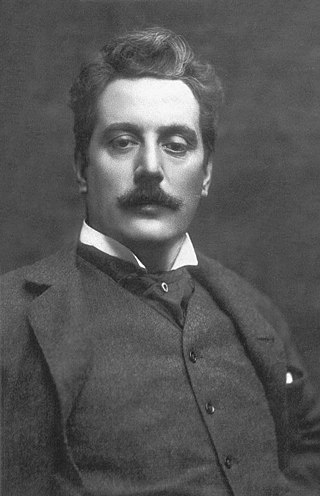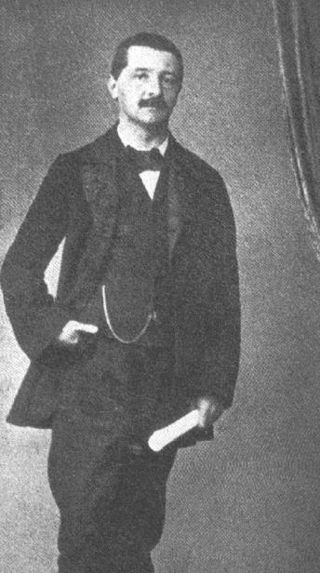
Pietro Alessandro Gaspare Scarlatti was an Italian Baroque composer, known especially for his operas and chamber cantatas. He is considered the most important representative of the Neapolitan school of opera.

Giacomo Antonio Perti was an Italian composer of the Baroque era. He was mainly active at Bologna, where he was Maestro di Cappella for sixty years. He was the teacher of Giuseppe Torelli and Giovanni Battista Martini.

Saint Cecilia, also spelled Cecelia, was a Roman virgin martyr and is venerated in Catholic, Orthodox, Anglican, and some Lutheran churches, such as the Church of Sweden. She became the patroness of music and musicians, it being written that, as the musicians played at her wedding, Cecilia "sang in her heart to the Lord". Musical compositions are dedicated to her, and her feast, on 22 November, is the occasion of concerts and musical festivals. She is also known as Cecilia of Rome.

Great Mass in C minor, K. 427/417a, is the common name of the musical setting of the mass by Wolfgang Amadeus Mozart, which is considered one of his greatest works. He composed it in Vienna in 1782 and 1783, after his marriage, when he moved to Vienna from Salzburg. The large-scale work, a missa solemnis, is scored for two soprano soloists, a tenor and a bass, double chorus and large orchestra. It remained unfinished, missing large portions of the Credo and the complete Agnus Dei.
Messa di Gloria is a nine movement mass, composed by Gioacchino Rossini for the Arciconfraternità di San Luigi. First performed on 24 March 1820 in the Chiesa di San Ferdinando in Naples, it is in the traditional form of a "Gloria" mass, that is a setting of the first two prayers of the Catholic mass, the Kyrie and Gloria. The Messa di Gloria was the only major piece of sacred music written while Rossini was still an active opera composer.
Francesco Scarlatti was an Italian Baroque composer and musician and the younger brother of the better known Alessandro Scarlatti.

Missa brevis usually refers to a mass composition that is short because part of the text of the Mass ordinary that is usually set to music in a full mass is left out, or because its execution time is relatively short.

Francesco Feo was an Italian composer, known chiefly for his operas. He was born and died in Naples, where most of his operas were premièred.

Igor Stravinsky composed his Mass between 1944 and 1948. This 19-minute setting of the Roman Catholic Mass exhibits the austere, Neoclassic, anti-Romantic aesthetic that characterizes his work from about 1923 to 1951. The Mass also represents one of only a handful of extant pieces by Stravinsky that was not commissioned. Part of the motivation behind its composition has been cited by Robert Craft and others as the product of a spiritual necessity, as Stravinsky intended the work to be used functionally.
The Tournai Mass is a polyphonic setting of the mass from 14th-century France. It is preserved in a manuscript from the library of the Tournai Cathedral.

Giacomo Puccini's Messa or Messa a quattro voci is a Mass composed for orchestra and four-part choir with tenor and baritone soloists. Strictly speaking, the piece is a full Mass, not a true Messa di Gloria.
The Missa sopra Ecco sì beato giorno is a musical setting of the Ordinary of the Mass, for 40 and 60 voices, by Florentine Renaissance composer Alessandro Striggio. It probably dates from 1565–6, during the reign of his employer, Cosimo I de' Medici. Lost for more than 400 years, it was recently rediscovered in Paris. Most of the mass is for five separate choirs of 8 voices each, with the closing Agnus Dei being for five separate choirs of 12 voices each; all of the voice parts are fully independent. With its huge polychoral forces, climaxing on sixty fully independent parts, it is the largest known polyphonic composition from the entire era.
Giovanni Benedetto Platti was born possibly 9 July 1697 in Padua, then belonging to Venice. He was an Italian Baroque composer and oboist. He died 11 January 1763 in Würzburg.
Austrian composer, Michael Haydn's Missa Hispanica or Missa a due cori, Klafsky I:17, MH 422, was presumably written for Spain, but there is no evidence of its ever having been performed there during Haydn's lifetime. The mass is scored for 2 oboes, 2 bassoons, 2 horns in low C, F and G, 2 trumpets in C, timpani, strings, basso continuo, SATB soloists, and two mixed choirs.

The Mass in B minor is Johann Sebastian Bach's only setting of the complete Latin text of the Ordinarium missae. Towards the end of his life, mainly in 1748 and 1749, he finished composing new sections and compiling it into a complex, unified structure.
The Missa Gaudeamus is a musical setting of the Ordinary of the Mass by Franco-Flemish composer Josquin des Prez, probably composed in the early or middle 1480s, and published in 1502. It is based on the gregorian introit Gaudeamus Omnes and its setting is for four voices.

The Kronstorfer Messe, WAB 146, is a missa brevis composed by Anton Bruckner in 1843-1844.

Missa cellensis refers to two masses by Joseph Haydn:

Missa Sanctae Caeciliae in G major, ZWV 1, is a mass for voices and orchestra by Jan Dismas Zelenka. It was completed in 1711 as his first work for the Dresden court.

Messe de minuit pour Noël, H.9, is a mass for four voices and orchestra by Marc-Antoine Charpentier, written in 1694 based on the melodies of ten French Christmas carols. Charpentier called for eight soloists, a duo of two sopranos and two trios of alto, tenor and bass, but it can be performed by five soloists. Choir and orchestra are in four parts, scored for flutes, strings, organ and basso continuo. The mass is regarded as a unique work in both the composer's work and in the genre. While in Charpentier's time, the mass was performed by all-male choirs, it has later been performed and recorded also by mixed choirs with modern instruments.














